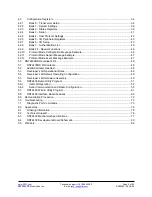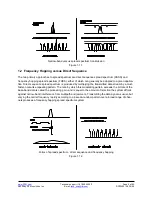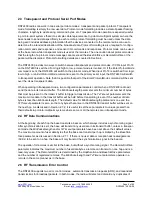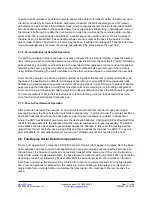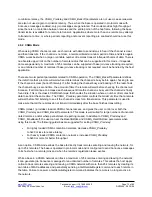
www.RFM.com
Technical s1.678.684.2000
Page 14 of 82
©2009 by RF Monolithics, Inc.
E-mail:
DNT2400 - 08/18/09
CSMA modes work well in many applications, but CSMA has some limitations, as summarized below:
•
Bandwidth is not guaranteed to any remote.
•
Marginal RF links to some remotes can create a relatively high chance of
collisions in heavily loaded networks.
2.9.3 TDMA Modes
TDMA modes provide guaranteed bandwidth to some or all of the remotes in a network. Remotes that
register with the base receive several special parameters, including ranging information and a specific
channel access time slot assignment. TDMA registrations are always leased and must be renewed every
250 hops. The DNT2400 provides three TDMA access modes, as discussed below.
TDMA Dynamic Slots (mode 2) is used for general-purpose TDMA applications where scaling the capac-
ity per slot to the number of active remotes is automatic. Each remote that registers with the base
receives an equal time slice. As new remotes join, the size of the TDMA remote slots shrinks accordingly.
The number of slots, individual slot start times, and the RemoteSlotSize are computed automatically by
the DNT2400 network in this mode. The user should note that the bandwidth to each remote will change
immediately as remotes join or leave the network. When running in protocol mode on a remote, care must
be taken not to generate messages too long to be sent in a single hop due to automatic RemoteSlotSize
reduction.
TDMA Fixed Slots (mode 3) is used for applications that have fixed data throughput requirements, such
as isochronous voice or streaming telemetry. The slot start time and the RemoteSlotSize are computed
automatically by the DNT2400 network in this mode. The user must set the number of slots using the
MaxSlots parameter. The base radio will allocate remote slot sizes as if MaxSlots number of remotes are
linked with the base, even when fewer remotes are actually linked. In this mode, the remote slot sizes are
constant.
TDMA with PTT (mode 4) supports remotes with a "push-to-talk" feature, also referred to as "listen-
mostly" remotes. This mode uses fixed slot allocations. Remotes can be registered for all but the last slot.
The last slot is reserved for the group of remotes that are usually listening, but occasionally need to
transmit. In essence, the last slot is a shared channel for this group of remotes. When one of them has
data to send it keys its transmitter much like a walkie-talkie, hence the name push-to-talk (PTT). There is
no limit to the number of remotes that can listen to the last slot.
The slot start time and the RemoteSlotSize are computed automatically by the DNT2400 network in mode
4. The user must specify the number of slots using the MaxSlots parameter. The last slot is reserved for
the PTT remotes. The user must configure PTT remotes individually to select mode 4 operation. The
user's application must ensure that only one PTT remote at a time is using the slot.
2.10 Transmission Configuration Planning
Because frequency hopping radios change frequency periodically, a single message may be sent in one
or more RF transmissions. The length of time the radio stays on a frequency, the hop duration, impacts
both latency and throughput. The longer the radio stays on a single frequency, the higher the throughput
since the radio is transmitting for a higher percentage of the time, but latency is also higher since radios
may have to wait longer to transmit. So latency and throughput trade off against one another. The




